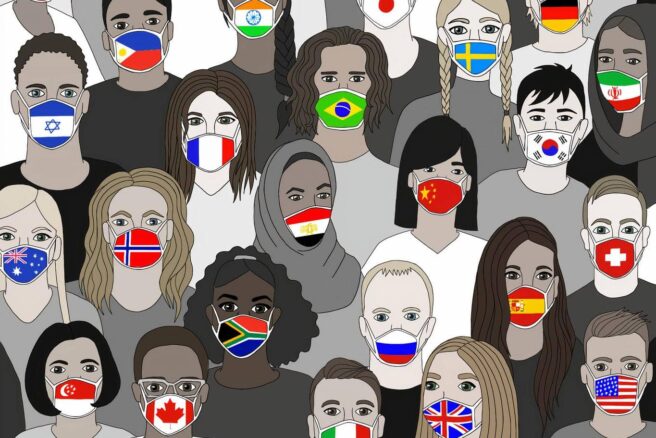The coronavirus pandemic has showed that the Global North is a lot more vulnerable for pandemics than was previously thought. Preparedness is only one factor in how a country fares during a pandemic. Successful responses depend on local circumstances influenced by political economies and cultures.
During the last two decades, global health initiatives have scaled up coordination to develop pandemic preparedness capacities. Despite these efforts, the COVID-19 pandemic evidences that such preparedness is not sufficient.
This challenges the ‘blame’ discourses used to rationalize how the lack of policy implementation in the Global South leads to the emergence of new epidemic outbreaks. The great variety of responses during the ongoing pandemic brings forth the role played by social and political cultures, a perspective that is often neglected in technical approaches.
The International Health Regulations
The ongoing Coronavirus pandemic is without doubt the most acute pandemic emergency since the foundation of the World Health Organization (WHO) in 1948. In charge of managing international policy for prevention, promotion, and intervention in the field of health, the WHO is a prominent international advocate for the development of pandemic preparedness capacity across the globe.
In the context of global infectious diseases, this means building political, economic, social, and scientific capacities to face emergencies that, while predictable to a certain extent, cannot be fully known. As sociology professor Andrew Lakoff has argued, the impossibility of knowing the threat we need to prepare for, or when and where it will strike, is probably the most distinctive characteristic of the understanding of pandemics that has developed during the last two decades.
This has crystallized into the so-called “all-hazards approach”, whereby preparedness measures should be developed that can be implemented in front of any possible emergency.
The impossibility of knowing the threat we need to prepare for is probably the most distinctive characteristic of the understanding of pandemics that has developed during the last two decades.
The adoption of this approach is most evident in the International Health Regulations (IHR) by the WHO, that sets a global framework for pandemic preparedness and protection. Published in 2005, the IHR is an ambitious legally binding document signed by almost all the organization’s members.
The IHR requires member states to build key response capacities, such as economic, regulatory, laboratory, and surveillance capacities. Since the publication of the IHR, we have seen several Public Health Emergencies of International Concern (a notion created with IHR) declared by the WHO, although none of them fully tested IHR capacity to respond to an ongoing event.
Some declared health emergencies, like the H1N1 Influenza in 2009, failed to reach the level of severity expected when WHO declared it a pandemic. Others like the Ebola crisis in 2014 or the Zika outbreak in 2016, remained localized and therefore did not have the chance to demonstrate how the implemented regulations worked at the international level.
Pandemic narratives and COVID-19
Preparedness strategies have also been influenced by a ‘pandemic narrative’ that since the 1990s has anticipated an imminent pandemic of apocalyptic proportions. This narrative is exemplified in Laurie Garrett’s popular science bestseller The Coming Plague (1996), that was key in bringing pandemic concerns to a wider public. In his most recent book, medical anthropologist Christos Lynteris has called this “the pandemic imaginary”, referring to a variety of past-inspired future-building doomsday representations that span books like Garrett’s, health and security policies, research, and popular media.
In the absence of an actual pandemic event, anticipation practices have produced virtual accounts of pandemics, as security researcher Limor Samimian-Darash (2013) has described. These virtual accounts, produced with the help of simulation, calculation, and modelling techniques, have had a significant effect on the type of preparedness measures taken in advance, marking the path for the design of response protocols, stockpiling, and other forms of capacity building.
However, time and again, not only have pandemic emergencies underperformed — falling short of a prophesized apocalyptic event — they have also defied simulations which, rather than model an actual event, have instead served to test the tests themselves, designed to assess preparedness capacities. Still, these exercises in future-making put forward concrete pandemic narratives that are surrounded by a fantasy of control that derives from virtual accounts that fail to actualize.
The pandemic challenges the assumptions and narratives of development, whereby Global North countries are models for the rest of the world to follow in implementing global health policies.
COVID-19 seems to be fulfilling pandemic prophecies much more accurately than other recent emergencies. Meanwhile it is also putting assumptions made when evaluating implementation procedures for campaigns like IHR, to test.
For example, when looking at how pandemic preparedness policies and programmes are built into national emergency planning, countries from the Global North tend to implement their policies and capacities quickly following publication of new policy, while countries in the Global South struggle to find the economic and human resources to fulfil WHO requirements. This has led to an assumption that countries in the Global North are therefore better prepared, which, conversely, has occasionally been used to explain why outbreaks of pandemic potential tend to start in lower- and middle-income countries but fail to spread to Europe or North America.
However, COVID-19 has challenged this assumption when first the European countries, and later the US, struggled to tackle the pandemic, situating the seemingly fully prepared and invulnerable Europe at its epicentre. This has raised the question of how prepared the Global North actually was, a question that seems easy to answer: not very.
Global Health dynamics
As countries in the Global North see some of the highest figures of COVID-19 deaths, the pandemic challenges the assumptions and narratives of development, whereby Global North countries are models for the rest of the world to follow in implementing global health policies. A long standing critique of global health policy is its reinforcement of North/South postcolonial dynamics.
Funding trends, partnerships, and clinical trials in the context of global health often take place under dynamics of inequality, with Global North actors often playing a leading role in global health initiatives.
In this sense, Global Health stops being a defined path forward that the Global North always walks first, marking the way. If even the flagbearers of the preparedness enterprise have failed to act timely in front of this global health crisis, what was the purpose of pushing lower- and middle-income countries with limited resources to implement policies that did not address the most acute deficiencies in their healthcare systems?
Examples from countries with previous experience managing emerging epidemics might place the Global South in an exemplary position for a change.
Although the full impact of the COVID-19 pandemic globally remains to be seen, it seems evident that a “successful” implementation of top-down preparedness policies has not led to a more efficient response. Numerous examples from the Global North show how successful implementation of global health policies does not translate into more efficient responses. In contrast, examples from countries with previous experience managing emerging epidemics might place the Global South in an exemplary position for a change.
The politics of a technical response
This leads us to consider a necessary follow up question: is it possible to be prepared in the way that preparedness policies expect countries to be?
The “one size fits all” preparedness paradigm takes poorly into account how diverse regions and political cultures respond to outbreaks. It is worth reflecting on how global and more situated social and political dynamics have influenced the management, spread and severity of the pandemic—dynamics that lay beyond regulatory documents and virtual pandemic accounts that formed the preparedness imaginary. As SARS-CoV-2 viruses spread around the globe, national governments varied considerably in their responses.
In Europe and the US testing and tracking, confinement and distancing measures, hygiene management or building herd immunity formed the bricolage of response strategies as national governments prioritised outcomes to protect citizens and national economies, and to avoid political backlashes.
Some tried to buy time to better prepare their healthcare sectors and understand the situation at hand. Others adopted measures deemed to cause least disruption, only to change course when infection — and death — rates rose, and intensive care units became strained beyond capacity. In other examples, governments have denied the scale of the problem (Brazil) or have used the outbreak to impose discriminatory and harmful political agendas upon minority groups (e.g. India).
News and social media scrutiny have shaped public perceptions of how governments and global health institutions are managing the pandemic. Whilst some countries have been praised for acting quickly to get the outbreak under control with testing and contact tracing (South Korea; Vietnam), some US states have experienced civil unrest calling for an end to lockdown, and international disbelief at its leaders’ denial or failure to grasp the severity of the situation.
Nations led by women (New Zealand, Germany, and most Nordic countries) have been commended for their sensitive and effective handling of their outbreaks. Whilst this has invoked some gendered stereotyping of women as possessing pragmatic and compassionate qualities, observers are also questioning the role of these nations’ political culture in influencing the kind of leadership demonstrated.
Is it possible to be prepared in the way that preparedness policies expect countries to be?
In Europe, Sweden has not locked down, keeping schools and non-essential businesses open, trusting its citizens to maintain social distancing and prevent transmission. Trust in the measures taken by one’s own government seems to have played a major factor, something that cannot be built into a preparedness policy package but that requires years of democratic and participatory practices.
Some lower- and middle-income countries, where healthcare and surveillance infrastructures are weak, and confinement and physical distancing are not easily enforceable, are developing their own responses. For example, the West African nations of Benin and Burkina Faso (where we work), have joined 100 similar clinical trials (in both high and low income countries) to test the ability of chloroquine antimalarial drugs to reduce viral loads.
They are also collaborating on the Api-COVID-19 trial to test the herbal derivative drug Apivirine, an antiretroviral used in the treatment of HIV-AIDS. Chloroquine is made available to patients and frontline healthcare staff despite insufficient evidence of its effectiveness.
Situatedness
The global pandemic has demonstrated how preparedness is but one factor for how a country fares during a pandemic – political cultures and political economies are also instrumental in shaping outbreak responses. These are difficult, if not impossible, to pin down in health regulations or predict through models, calculations, and simulations.
Instead, responses are situated. Even if it were possible to declare a single country’s response a model one, it would be hard to imagine some responses being possible elsewhere, for example in the case of Sweden. Also, decisions on healthcare and research investment shape a country’s ability to respond, and cannot be immediately scaled up as an emergency is declared.
Even if it were possible to declare a single country’s response a model one, it would be hard to imagine some responses being possible elsewhere, for example in the case of Sweden.
Responses are historical too. For example, would the US have responded differently under Barack Obama and, if so, from which directions and sources would praise or criticism have come? Different administrations respond differently, and are subject to different modes of scrutiny. Responses are currently being shaped within the climate of post-truth, characterised partly by distrust in experts and authorities, tying the conditions of this epidemic to the times we live in.
Thus, we can argue with some certainty the impossibility of knowing the threat to prepare for, and the futility of exclusively relying on technical solutions. Strategies like IHR or preparedness simulations struggle to tackle social problems, and not only in terms of regional disparities in economic and technical capacities.
Thus, we can argue with some certainty the impossibility of knowing the threat to prepare for, and the futility of exclusively relying on technical solutions.
Dominant approaches cannot appreciate how the social gets under the skin; how different political systems, public cultures, levels of trust, media scrutiny, and indeed political moments modulate response dynamics.
While close examination of the technical and scientific aspects is important in order to understand the impact of this virus, understanding the situatedness of the responses is key when we want to grasp the specific challenges of globalized health events such as the COVID-19.
Jose A. Cañada is a postdoctoral researcher at the University of Helsinki. He is currently conducting research on the implementation of Global Health policy in West Africa.
Salla Sariola is a Finnish Academy Research Fellow in sociology at University of Helsinki. Her current research on the social study of microbes includes fermentation, composting, and exploring changing scientific practices on the microbiome and antimicrobial resistance in India, Benin, Burkina Faso, and Finland.
Andrea Butcher is a postdoctoral researcher in sociology at the University of Helsinki. Her recent research examines the socioeconomic, institutional and infrastructural dimensions of antimicrobial resistance in South Asia and West Africa.




